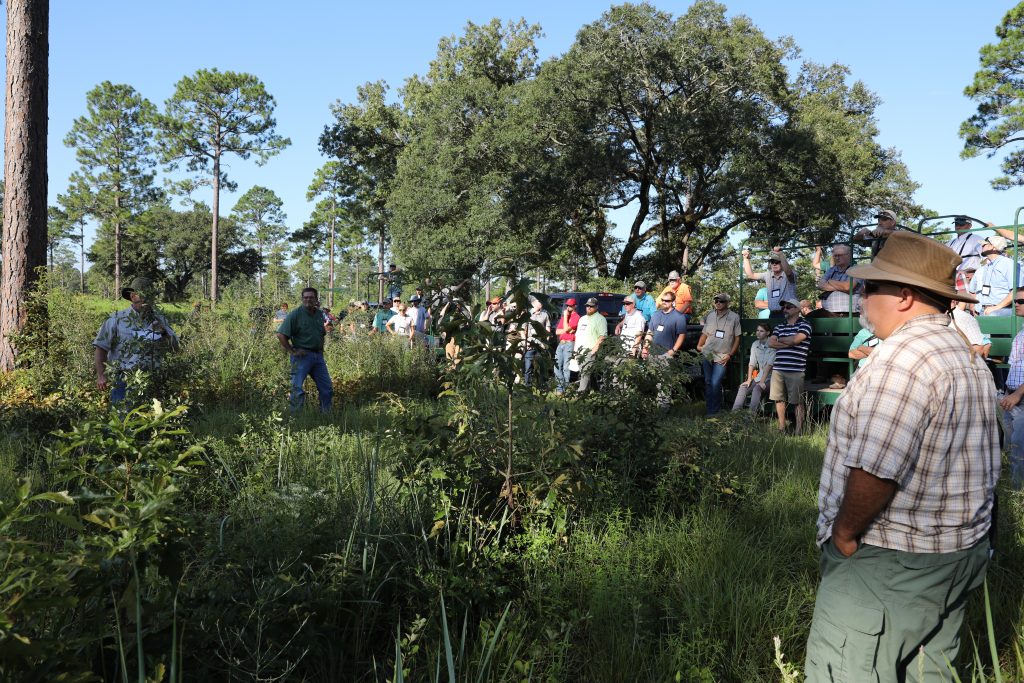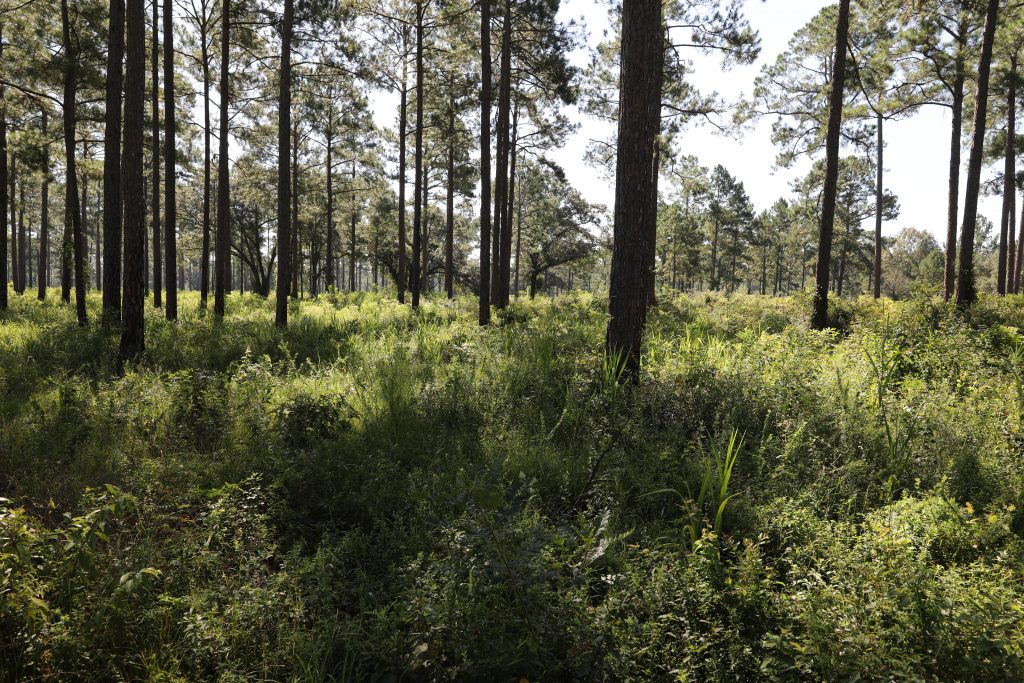
Our Virginia quail team spent the first week of August in Albany, Georgia, attending the National Bobwhite Technical Committee meeting (Thanks to the Georgia DNR and a local plantation as well as all sponsors for hosting a great meeting and field tour). It was hot in Virginia but hotter still down there. The quail management we saw was also hot…as in some of the most intensive (or “extensive” as they say – will explain later) quail management in the world – described by one of the world’s leading quail biologists as “The N.A.S.A. of the quail world.” And that is how they manage on the best of the quail plantations – shooting for the moon. They have the highest quail densities found on earth. Some would say artificially high…and I would agree. But it is heartening to know that almost 1/5th the way through the 21st century bobwhites can still be produced in these numbers (densities as high as 3 or more quail per acre).
These privately owned plantations are large – ranging from a couple thousand acres to over 20,000, and over 300,000 acres of them are within an hour of Albany. There’s another 300,000 north of Tallahassee, Florida, and still more in Alabama. The old adage “more begets more” is proven here. For those folks who believe there may be some unknown combination of environmental factors that are causing the quail decline (pesticides, disease, climate change, etc.) this area is not immune to those things. To the north, south, east and west of the plantation country is some of the most intensive center pivot agriculture in the world, rivaling anything found in the mid-west. And if climate change were the driving factor in quail decline…being further south they’d know it before us. There may indeed be environmental factors affecting many wildlife species, including quail…but the basic ingredients for baking a quail cake have not changed. While some of what the plantations do may be the moonshot, most of what they do is not rocket science.
The building blocks of their success are: large contiguous acres, intensive use of prescribed fire, systematic incorporation of disking, good distribution of all cover types, wise use of herbicides, well managed quail harvest, and sound scientific research as a feedback loop. And let me say that you can have plenty of quail by doing all these things and stopping right there. I think these plantations could easily reach 10 – 15 covey hunting days (most Virginians would be happy with 2 to 6 covey days) by using the aforementioned techniques alone. But to get to 20, 30, even 35 or 40 covey days…that is where shooting for the moon begins.
Their research program is an example…they have had radio-collared quail as part of the Albany Area Quail Project every year since 1992. They have had over 30,000 quail radio-collared (including those from Tall Timbers Research Station) during that 26-year period! While some people still scoff at the need to land people on the moon, the technological developments that the moon landing precipitated has benefitted every single one of us in our lifetime (paraphrased from their presentation at the meeting).
Now…let’s talk about “extensive” quail management. I had a tough time at first understanding this…but then realized it just boils down to thinking outside the box, not being afraid to challenge some norms, and being willing to go above and beyond in management. There is some controversy in the quail ranks over some of what the plantations do to achieve their success. And it is in this extensive management where that develops. I consider three major things being applied there to be extensive in nature: 1) supplemental feeding, 2) scientific, year-around, legal mammalian predator control and 3) extra incorporation of brood fields (ragweed galore) to include occasional deep plowing, liming and fertilizing where needed.

Before I elaborate, I’d like to say a few words on behalf of the owners and managers of the plantations. It is easy to sit outside that circle and accuse them of being wealthy elitists having nothing better to do with their money. But they could do anything with their money they wanted to do…and they choose to put untold millions into quail recovery and large scale land conservation. They should be applauded for that. As for the managers…having tried myself just to manage my 40 acres…and having seen how hard our staff works to try to stay ahead of the game on their Wildlife Management Areas…I do not think a plantation manager or their staff know what a 40-hour work week is. I suspect it takes 50 or 60 hours a week, almost year around to keep these plantations in shape. And just try to imagine the pressure to produce results.
Back to the extensive techniques – supplemental feeding. On one plantation we visited there were 115 miles of feed lines evenly distributed through the grounds. Yes…miles. They have perfected the feeding system. In winter they use corn and milo, in summer milo alone. The feed is spread by tractor and feed wagon every two weeks, and they have it figured down to the number of seeds per square foot necessary to last for that time period. Their research has clearly shown within their ecosystem, supplemental feeding increases quail productivity. Research also demonstrated that contrary to intuition, supplemental feeding did not make finding quail easier, in fact, sometimes it made it harder. The way it is done it is not baiting. I am not a fan of it personally…but for them it is legal, affordable, and it produces more quail.
Predator control also continues to raise some hackles, but for the plantations it is legal, scientifically done, and shown to be effective within their ecosystem. They focus on mid-sized mammalian predators (raccoons, opossums, skunks, etc.). Their approach is beyond the means of most, but in Virginia trapping is a legal, honorable and protected form of outdoor recreation. If landowners here wish to employ trapping as a legal form of predator control, I feel it is their prerogative.
The last one is the extensive incorporation of brood fields. As much as 30% of their total land area (heavily thinned pine ecosystem) is made up of well distributed 2 – 5 acre fields. The fields are managed specifically for ragweed. They soil test, add amendments accordingly, and lime where needed. They use fall disking, disking each field every year. And about 1/3 of each field is deep plowed with a bottom plow annually. They have shown that this deep plowing is sometimes necessary to break up the hardpan that develops after years of disking. It is not so much that these methods are new. What makes them “extensive” is the systematic way they are incorporated into the plantations. All these techniques are discussed in detail in the Tall Timbers Bobwhite Quail Management Handbook which can be purchased via their website.
So where does that leave the average owner of 100 or 200 acres in Virginia? I would say first make sure you have maximized the habitat basics before thinking about adding anything more. Within a pine timber system, if it is practical for you, I’d suggest seriously considering adding in more openings next time you thin your timber. It will take time before they can be disked, and will take a long time before they can be plowed, but quail management is a long term endeavor.
Have your habitat evaluated by a quail ecologist. If all agree that the habitat is excellent and should be supporting more quail than are being found, you might consider legal trapping, especially late in the season to see if predators could be suppressing your quail population. And I think supplemental feeding will rarely be of value for most Virginians with one exception, during periods of prolonged heavy snow cover. A landowner might consider providing spread feed (not concentrated feeders) in areas where coveys are known to exist in good cover (when legal – check the feeding laws in our DGIF Regulations Digest or on our website www.dgif.virginia.gov ).
I have been to the “promised land” for quail now several times – Texas, Georgia, Florida, Kansas…duly blessed to have seen it with my own eyes. Life’s fortunes may never take me back there again, but a bucket list item has been crossed off for me. And I am happy to still be a bird hunter here in Virginia after having seen all that. I still enjoy finding 4 or 5 woodcock a day, or seeing a quail covey from time to time. I heard this said somewhere before, something to this effect “It must be sad if, after having caught a lot big fish, you can never be happy catching little fish again.”






